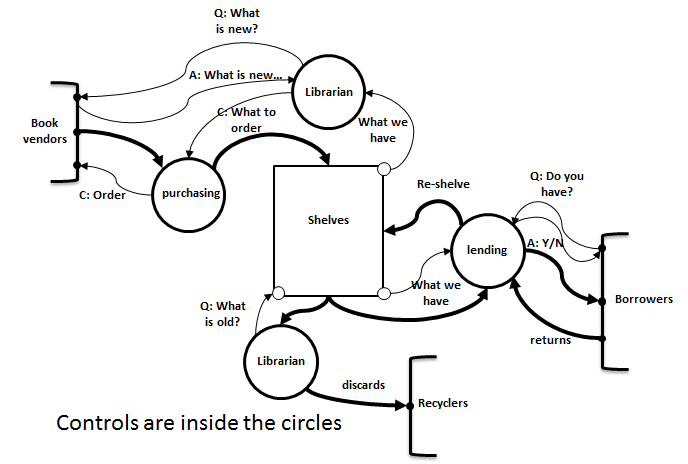TINST 401 Week 3 In-class Exercise
This exercise will be essentially like last week's except that we will strive for more complexity. We will do this by taking an existing model and expanding the scope (increasing the boundary) to include entities that were previously merely sources or sinks.
Procedure
In groups of 3-4:
You can use Microsoft Paint or PowerPoint drawing (or any drawing program you have) to produce the diagram.
Look at the diagram as given here, the system of interest (SoI). In this diagram you will see circle objects surrounding the library shelves (stock). These represent subsystems (sub-processes) that are inside the SoI (the library). As noted in the diagram the controls for flows are to be found inside those circles. The objective of this exercise is to open up those sub-processes and identify the sub-stocks (if any) and the controls. Note the flows of messages from vendors to librarians, to the purchasing dept., etc. These are processed internally to the sub-processes. For example, the librarian gets information about the current books in the stacks and queries the book vendors about what might be a new book that they should have in the library. “Q:” means a query message. “A:” means a reply answer message. “C:” means a command message. These are just examples (simple ones) to show you how communications flow in the SoI and between the SoI and the external environment of sources and sinks.
Here is the starting system model.

Believe it or not this figure has some deep similarities to Fig. 31 in Meadows' book. In the above diagram I have encapsulated many of the internal influence relations (like the “perceived sales” within the sub-processes.
Discuss in the group what other entities (if any) or flows should be in this model (Hint: you can disregard energy for now) to make it realistic at the current level of organization. What might be some interesting questions that you could have about the library dynamics? For example: What happens when borrower demand increases (as it typically does in summer)? Consider the boundary to be the fixed walls of the building that house the shelves. Use your imagination and whatever working knowledge you have about libraries. There could be things you think of that I didn't. There are no necessarily right answers - just ideas. If you do add sub-processes and flows be sure to label them.
Next start dissecting the sub-processes. You might start with purchasing. Clearly purchasing gets a command from the librarian on what books to order. They send orders to the vendors and receive the books that come in. There is likely to be another stock of books inside that circle where new books are temporarily stored until they can be shelved.
Follow the flow of books through the shelves stock and to the borrower and back from returns. Then you can tackle the librarian function.
What you should produce is a more complex diagram that looks more like Meadows' Fig. 31. I'll be wandering around to assist, answer questions, etc. If you are using PowerPoint I have placed a file HERE that you can download if you wish. Or you could save a copy of the image in this page as a local .png file. Put your cursor over the image and right click. You can choose to 'save image as...' or just copy the image and paste it into Paint. Whatever works for your group.
Make sure everyone's name is in both the drawing and the accompanying text file that contains the same information as before with respect to labels on stocks, flows, and controls. Your goal is to produce a drawing and descriptions that would be readable by any person sufficiently knowledgeable about systems models and they would quickly understand what you have produced.
Turn in the drawing and text - one person in the group. Zip the two files together and call it exercise3.zip.
Grading will be based on the quality of thought that you put into this exercise. This will be evidenced by 1) any additional entities that you think need to be in the model, 2) your demonstrated dissection of the sub-processes (they should make sense!). On the latter you could get full marks for dissecting only one of the sub-processes if you do it really well so that I can see you understand what you are doing.